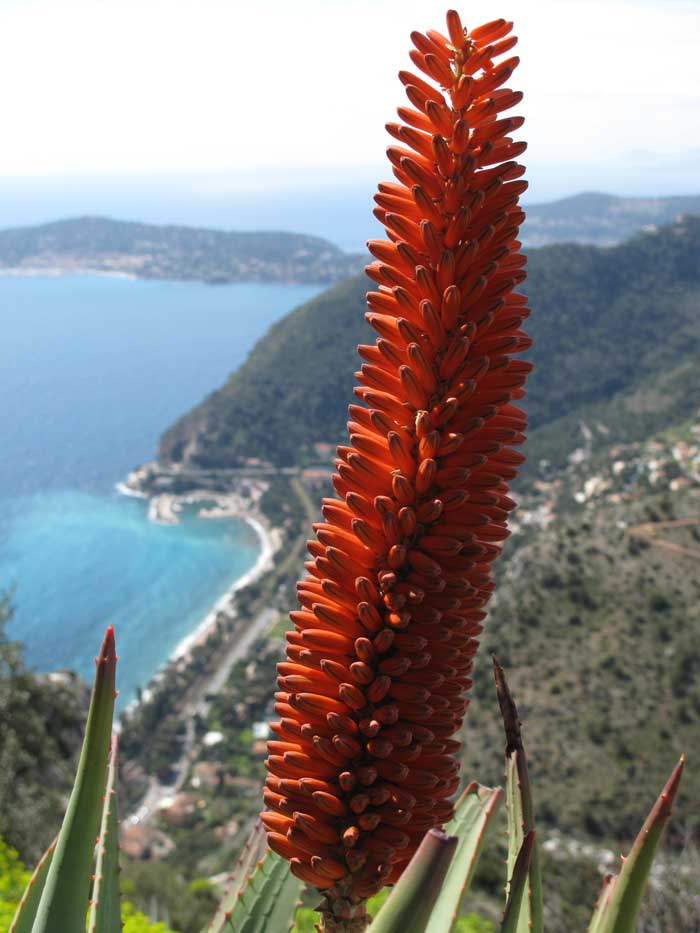
Aloe arborescens
Classification System: APG IV
Superregnum: Eukaryota
Regnum: Plantae
Cladus: Angiosperms
Cladus: Monocots
Ordo: Asparagales
Familia: Asphodelaceae
Subfamilia: Asphodeloideae
Genus: Aloe
Species: Aloe arborescens
Subspecies: A. a. subsp. arborescens – A. a. subsp. mzimnyati
Name
Aloe arborescens Mill., 1768
Synonyms
Aloe perfoliata var. arborescens (Mill.) Aiton
Catevala arborescens (Mill.) Medik.
Distribution
Native distribution areas:
References
Miller, P. 1768. Gard. Dict. ed. 8: n.º 3
USDA, NRCS. 2006. The PLANTS Database, 6 March 2006 (http://plants.usda.gov). Data compiled from various sources by Mark W. Skinner. National Plant Data Center, Baton Rouge, LA 70874-4490 USA.
Links
Govaerts, R. et al. 2019. Aloe arborescens in World Checklist of Selected Plant Families. The Board of Trustees of the Royal Botanic Gardens, Kew. Published online. Accessed: 2019 Feb. 10. Reference page.
International Plant Names Index. 2019. Aloe arborescens. Published online. Accessed: Feb. 10 2019.
The Plant List 2013. Aloe arborescens in The Plant List Version 1.1. Published online. Accessed: 2019 Feb. 10.
Tropicos.org 2019. Aloe arborescens. Missouri Botanical Garden. Published online. Accessed: 10 Feb. 2019.
USDA, ARS, Germplasm Resources Information Network. Aloe arborescens in the Germplasm Resources Information Network (GRIN), U.S. Department of Agriculture Agricultural Research Service.
Vernacular names
Afrikaans: Kransaalwyn
Deutsch: Tintenfisch-Aloe
English: Krantz or Candelabra Aloe
suomi: Rohtoaaloe
hornjoserbsce: Wohnjowy alowej
magyar: Fásodó aloé
日本語: キダチアロエ
latviešu: Kokveida alveja
polski: Aloes drzewiasty
svenska: Trädaloe
Aloe arborescens, the krantz aloe or candelabra aloe, is a species of flowering succulent perennial plant that belongs to the genus Aloe, which it shares with the well known and studied Aloe vera. The specific epithet arborescens means "tree-like".[2] Aloe arborescens is valued by gardeners for its succulent green leaves, large vibrantly-colored flowers, winter blooming, and attraction for birds, bees, and butterflies.
Description
Aloe arborescens is a large, multi-headed, sprawling succulent, and its specific name indicates that it sometimes reaches tree size.[3] A typical height for this species is 2–3 metres (6.6–9.8 ft) high. Its leaves are succulent and are green with a slight blue tint. Its leaves have small spikes along its edges and are arranged in rosettes situated at the end of branches.[4] Flowers are arranged in a type of inflorescence called a raceme. The racemes are not branched but two to several can sprout from each rosette. Flowers are cylindrical in shape and are a vibrant red-orange color.[3]
Taxonomically, it forms part of the Arborescentes series of very closely related Aloe species, together with Aloe pluridens and Aloe mutabilis.[5]
Distribution
Aloe arborescens is endemic to the south eastern part of Southern Africa. Specifically, this range includes the countries of South Africa, Malawi, Mozambique, and Zimbabwe.[4] It has the third largest distribution amongst the aloe genus.[3] Although Aloe arborescens has adapted to many different habitats, its natural habitat usually consists of mountainous areas, including rocky outcrops and exposed ridges. Its common name krantz aloe refers to the Afrikaans word "krans" (spelling possibly influenced by German "Kranz"),[6] which means a rocky cliff. Its habitat can vary, and it is one of only a few species of aloe that is found growing from sea level up to the tops of mountains.[3]
It is also widely distributed (to the point of becoming naturalized) in the western Mediterranean, Australia, California, Japan, South Korea and the Marshall Islands. It is an invasive species in Portugal.[7]
Cultivation
Aloe arborescens is valued by gardeners for its succulent green leaves, large vibrantly-colored flowers, and winter blooming. The sweet nectar attracts birds, butterflies, and bees. With a minimum temperature of 10 °C (50 °F),[8] in temperate regions it is grown under glass. The cultivar A. arborescens 'Variegata' has gained the Royal Horticultural Society's Award of Garden Merit.[9] In Southern Africa, Aloe arborescens is traditionally planted around kraals (domestic stock enclosures) as a living fence or security hedge. It often happens that the position of old kraals can still be seen many years after they have been abandoned, because the aloes persist. It is easily propagated by cuttings.[3]
References
Wikimedia Commons has media related to Aloe arborescens.
Martínez Richart, A.I. (2019). "Aloe arborescens". IUCN Red List of Threatened Species. 2019: e.T110688013A110688030. doi:10.2305/IUCN.UK.2019-1.RLTS.T110688013A110688030.en. Retrieved 12 November 2021.
Harrison, Lorraine (2012). RHS Latin for gardeners. United Kingdom: Mitchell Beazley. p. 224. ISBN 9781845337315.
Hankey A, Notten A (2004). "Aloe Arborescens". PlantZAfrica, South Africa National Biodiversity Institute.
"Aloe arborescens Miller". Aloes of the Huntington Gardens. 2007.
Reynolds, GW (1950). The Aloes of South Africa. Aloes of South Africa Book Fund, Cape Town.
"Krantz". 16 September 2021.
"Aloe arborescens". IUCN Red List of Threatened Species. Retrieved 27 November 2020.
RHS A-Z encyclopedia of garden plants. United Kingdom: Dorling Kindersley. 2008. p. 1136. ISBN 978-1405332965.
"RHS Plant Selector - Aloe arborescens 'Variegata'". Retrieved 14 March 2020.
Retrieved from "http://en.wikipedia.org/"
All text is available under the terms of the GNU Free Documentation License

